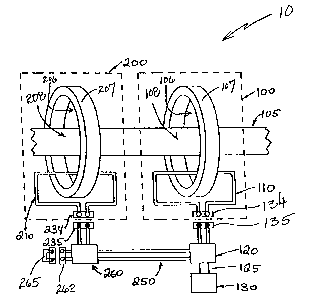Une partie des informations de ce site Web a été fournie par des sources externes. Le gouvernement du Canada n'assume aucune responsabilité concernant la précision, l'actualité ou la fiabilité des informations fournies par les sources externes. Les utilisateurs qui désirent employer cette information devraient consulter directement la source des informations. Le contenu fourni par les sources externes n'est pas assujetti aux exigences sur les langues officielles, la protection des renseignements personnels et l'accessibilité.
L'apparition de différences dans le texte et l'image des Revendications et de l'Abrégé dépend du moment auquel le document est publié. Les textes des Revendications et de l'Abrégé sont affichés :
| (12) Demande de brevet: | (11) CA 2575506 |
|---|---|
| (54) Titre français: | AGENCEMENT DE COUPLEURS INDUCTIFS EN SERIE POUR TRANSMISSION DE DONNEES |
| (54) Titre anglais: | ARRANGEMENT OF DAISY CHAINED INDUCTIVE COUPLERS FOR DATA COMMUNICATION |
| Statut: | Réputée abandonnée et au-delà du délai pour le rétablissement - en attente de la réponse à l’avis de communication rejetée |
| (51) Classification internationale des brevets (CIB): |
|
|---|---|
| (72) Inventeurs : |
|
| (73) Titulaires : |
|
| (71) Demandeurs : |
|
| (74) Agent: | BORDEN LADNER GERVAIS LLP |
| (74) Co-agent: | |
| (45) Délivré: | |
| (86) Date de dépôt PCT: | 2005-10-17 |
| (87) Mise à la disponibilité du public: | 2006-06-22 |
| Licence disponible: | S.O. |
| Cédé au domaine public: | S.O. |
| (25) Langue des documents déposés: | Anglais |
| Traité de coopération en matière de brevets (PCT): | Oui |
|---|---|
| (86) Numéro de la demande PCT: | PCT/US2005/037463 |
| (87) Numéro de publication internationale PCT: | WO 2006065340 |
| (85) Entrée nationale: | 2007-01-29 |
| (30) Données de priorité de la demande: | ||||||
|---|---|---|---|---|---|---|
|
L'invention concerne un agencement de coupleurs inductifs. L'agencement comprend un premier coupleur inductif sur un conducteur, et un second coupleur inductif sur ledit conducteur. Le premier coupleur inductif comporte un premier enroulement destiné à un signal de données, et le second coupleur inductif comporte un second enroulement destiné au signal de données. Cet agencement comprend aussi un module de connexion qui connecte le premier enroulement au second.
There is provided an arrangement (10) of inductive couplers (100, 200). The
arrangement includes a first inductive coupler (100) on a conductor (105), and
a second inductive coupler (200) on the conductor (105). The first inductive
coupler (100) has a first winding (110) for a data signal, and the second
inductive coupler (200) has a second winding (210) for the data signal. The
arrangement also includes a connection module (260) that connects the first
winding to the second winding.
Note : Les revendications sont présentées dans la langue officielle dans laquelle elles ont été soumises.
Note : Les descriptions sont présentées dans la langue officielle dans laquelle elles ont été soumises.

2024-08-01 : Dans le cadre de la transition vers les Brevets de nouvelle génération (BNG), la base de données sur les brevets canadiens (BDBC) contient désormais un Historique d'événement plus détaillé, qui reproduit le Journal des événements de notre nouvelle solution interne.
Veuillez noter que les événements débutant par « Inactive : » se réfèrent à des événements qui ne sont plus utilisés dans notre nouvelle solution interne.
Pour une meilleure compréhension de l'état de la demande ou brevet qui figure sur cette page, la rubrique Mise en garde , et les descriptions de Brevet , Historique d'événement , Taxes périodiques et Historique des paiements devraient être consultées.
| Description | Date |
|---|---|
| Demande non rétablie avant l'échéance | 2011-10-17 |
| Le délai pour l'annulation est expiré | 2011-10-17 |
| Inactive : Abandon.-RE+surtaxe impayées-Corr envoyée | 2010-10-18 |
| Réputée abandonnée - omission de répondre à un avis sur les taxes pour le maintien en état | 2010-10-18 |
| Inactive : IPRP reçu | 2008-02-22 |
| Lettre envoyée | 2007-04-23 |
| Inactive : Page couverture publiée | 2007-04-13 |
| Inactive : Lettre de courtoisie - Preuve | 2007-04-03 |
| Inactive : Notice - Entrée phase nat. - Pas de RE | 2007-03-26 |
| Inactive : Transfert individuel | 2007-03-05 |
| Demande reçue - PCT | 2007-02-23 |
| Exigences pour l'entrée dans la phase nationale - jugée conforme | 2007-01-29 |
| Demande publiée (accessible au public) | 2006-06-22 |
| Date d'abandonnement | Raison | Date de rétablissement |
|---|---|---|
| 2010-10-18 |
Le dernier paiement a été reçu le 2009-09-28
Avis : Si le paiement en totalité n'a pas été reçu au plus tard à la date indiquée, une taxe supplémentaire peut être imposée, soit une des taxes suivantes :
Veuillez vous référer à la page web des taxes sur les brevets de l'OPIC pour voir tous les montants actuels des taxes.
| Type de taxes | Anniversaire | Échéance | Date payée |
|---|---|---|---|
| Taxe nationale de base - générale | 2007-01-29 | ||
| Enregistrement d'un document | 2007-03-05 | ||
| TM (demande, 2e anniv.) - générale | 02 | 2007-10-17 | 2007-10-16 |
| TM (demande, 3e anniv.) - générale | 03 | 2008-10-17 | 2008-10-03 |
| TM (demande, 4e anniv.) - générale | 04 | 2009-10-19 | 2009-09-28 |
Les titulaires actuels et antérieures au dossier sont affichés en ordre alphabétique.
| Titulaires actuels au dossier |
|---|
| AMBIENT CORPORATION |
| Titulaires antérieures au dossier |
|---|
| RAM RAO |
| YEHUDA CERN |